Weeding the natural meadow
I work quietly, allowing my thoughts to fade away into just being. I especially don’t think about the enormity of my goal, and the only urgency I feel is the one. The weeds are going to seed.
The last three days I have spent in the natural meadow two levels below the house. Natural in that it has been left alone for 10 years and possibly longer, un-bothered by any rancher or previous owner. Before that, we think this whole area next to the Sierra Forest here was a goat or sheep farm, vulnerable like any ranch land to the grasses that come into native land from animal grazing.
The goal is to restore the meadow, 30′ x 80′, to existing and added California natives. Five years ago, I planted three deer grasses. Since then the field has been left alone and the dry grass removed with a weedeater once for fire safety. Last summer, I removed all the filaree.
I sit to weed, working from uphill to down in the 80 degree heat, grateful for the occasional breeze and the shade from the Yerba Santa, Eriodictyon crassifolium and Goldenfleece, Ericameria arborescens as I pass by them.
I work in the mornings and afternoons to avoid the midday heat and every afternoon I hear the chirp and coo from the quail who appear about 4pm. I see them fly in from the dry stream gully and they have grown used to me, I think, if I move slowly as I do. As they walk and bob, we work away peacefully together, me with my objective, them with theirs, and I listen…silently.
The main weeds I’m removing are the native Bedstraw Galium aparine, non-native Field Madder, Sherardia arvensis, Spreading Hedgeparsley, Torilis arvensis and English plantain, Plantago lanceolata. I was glad to see few Filaree, which I weeded out last summer on my ‘Filaree rampage.’
Natural meadow plants
As each swath of weeds is removed, the now spindly few native bulbs and flowers are left:
Elegant Brodiaea, Brodiaea elegans
Pretty face, Triteleia ixioides, now fading
Elegant Madia, Madia elegans
Heermann’s tarweed, Holocarpha heermannii
Farewell-to-Spring or actually Speckled Fairyfan, Clarkia cylindrical ssp. clavicornate
Indian Rice grass, Achnatherum hymenoides
Grand Mountain Dandelion, Agoseris grandiflora
Pearly everlasting, Anaphalis margaritacea
California Everlasting, Gnaphalium californicum
I hope that these natives will spread and feel more welcome without their weedy bullies bothering them and pushing them around.
I covered the bare earth with ‘native’ mulch, in other words, pine needles and chipped oak branches acquired locally. My hope is that the heat will not kill these natives used to, I’m sure, the shade from the weeds. I’ve been watering them a bit and intend to water both meadows once every couple weeks in the summer.
The wildflower seeds I started in seed trays continue to thrive and bloom. I’ve added three Wild lilacs, Ceanothus thyrsiflorus ‘Skylark’, three Cleveland sage ‘Pozo Blue’, ‘ Salvia clevelandii X leucophylla and a Sticky Monkey Flower, Mimulus aurantiacus calycinus. In the center of the field is an existing Wavy-leafed Soap Plant, Chlorogalum pomeridianum, just about to bloom.
I have only heard of restoration projects as community projects or on land conservancies, but while visiting my sister in New Zealand, I learned of their program for residential restoration subsides. The local government pays a certain amount for replacing non-natives with NZ native plants. I thought, even without government involvement here, why couldn’t I do a certain amount of restoring myself, according to my ability? The first project was the new south meadow which I’ve written about here on this blog.
This other area is what I’ve been calling the ‘natural meadow’ but I guess if I’m going to be fiddling with it, I should name it the East Meadow, for the direction it lies from the house. Now the weeding and mulching is complete after the three days, and the cost? Three pairs of gloves shot, my gardening jeans worn to a soft thin shred of fabric, and my shoes? Forget about it. My hands are awfully fatigued and one ligament in one hand I know is sprained.
I’m happy, though, and have already found a little treat in the meadow. A pure white Brodiaea, same shape as the blue…how does this happen…I’ve never seen a white one. Also, I just found out, (with the help of Dave’s Garden Plant ID forum) that this mystery plant in this new area is a CA native, Navarretia. Now I just need to wait until it blooms to ID it further. Fun!
Update:
No, not Navarretia, it’s Leptosiphon bicolor or True babystars…a CA native
Notes on Restoration:
Words that ring in my head…’weed and wait’ from Country Mouse’s post, Recreational Restoration Gardening
Wikipedia says, In the view of biologist E. O. Wilson, “Here is the means to end the great extinction spasm. The next century will, I believe, be the era of restoration in ecology”.
Releasing the Native Seedbank
Developing a Weed-Only Strategy to Promote the Local Natives
From 1985 to 1992, Shaw did extensive work to remove the exotics. After doingsome initial surveys of the property in 1992, he and I decided on a strategy that included the following five points: 1) learn to identify all the weeds and native plants on the property; 2) continue to remove the weeds, with a focus on the valley floor; 3) experiment with mowing and continue clearing with machetes; 4) dig up and bring native plants into a suburban garden to understand their functionality and interaction; and 5) when there were successes with the weed management techniques, we would expand the areas where the success occurred.




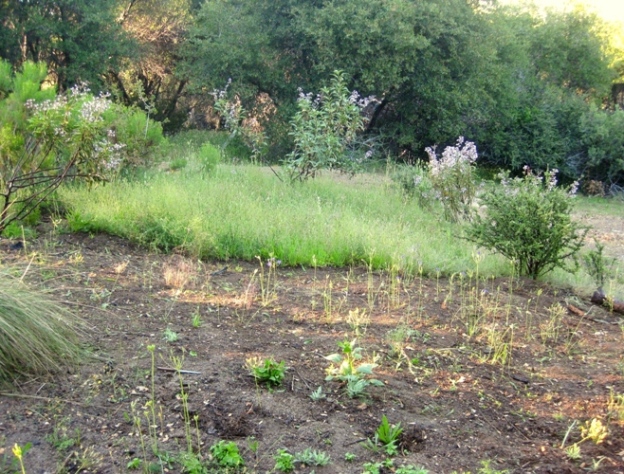

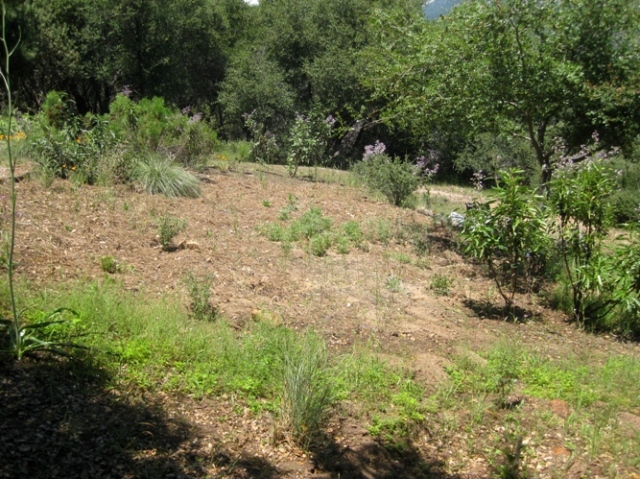
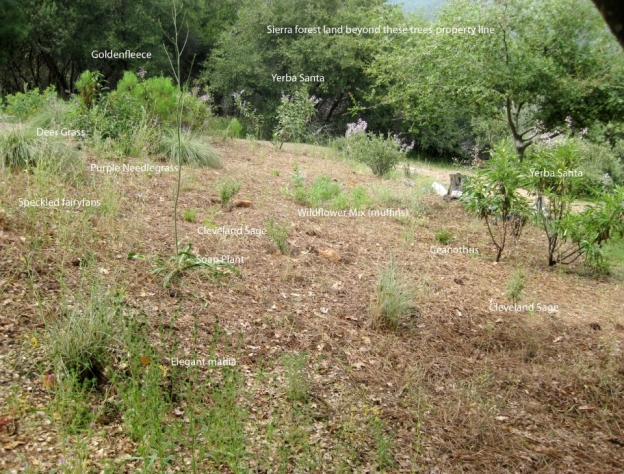

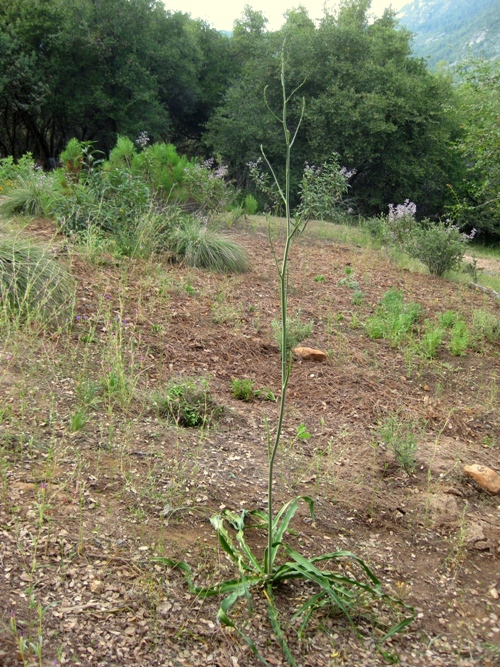

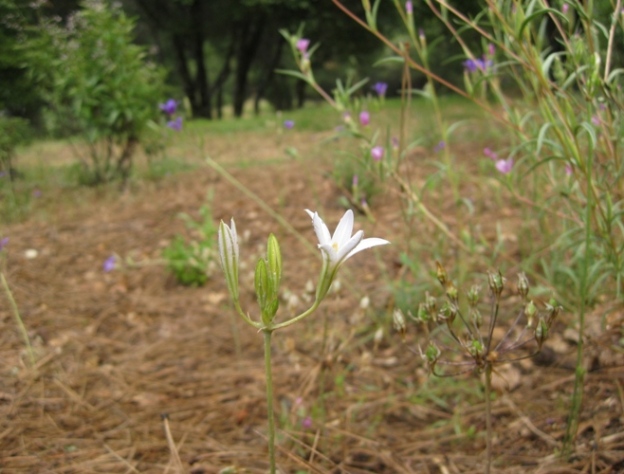
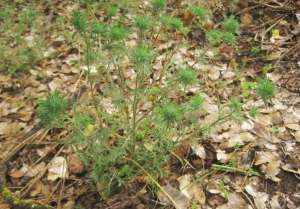
Pingback: Spring wildflowers: The blues | Sierra Foothill Garden